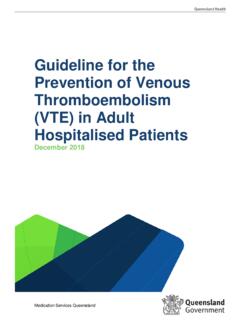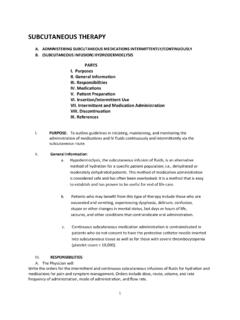Transcription of Management of Subcutaneous Infusions in Palliative Care
1 Management of Subcutaneous Infusionsin Palliative CareCentre for Palliative CareResearch and EducationPalliative Care AustraliaPO Box 24 Deakin WestACT 2600t: +61 2 6232 4433f: +61 2 6232 4434e: 2010 Developed in conjunction withCentre for Palliative Care Research and EducationQueensland HealthLevel 7, Block 7 Royal Brisbane & Women s HospitalHerston QLD 4029t: +61 7 3636 1449f: +61 7 3636 7942e: w: to the Syringe Driver Replacement Program Advisory Committee for their contribution towards the ' Management of Subcutaneous Infusions in Palliative Care' education materials: Vlad Alexandric, Deputy Chief Executive Officer, Palliative Care AustraliaCathy Bennett, Clinical Services Coordinator Palliative Care, Country Health SAPatrick Cox, Community Nurse, South Adelaide Palliative ServicesHelen Walker, Program Manager Palliative Care, WA Cancer and Palliative Care NetworkFunded by the Australian Government Department of Health and AgeingHMMU Nov 10 1287 Griffin_jkManagement of Subcutaneous Infusionsin Palliative CareCentre for Palliative CareResearch and EducationPalliative Care AustraliaPO Box 24 Deakin WestACT 2600t: +61 2 6232 4433f: +61 2 6232 4434e.
2 2010 Developed in conjunction withCentre for Palliative Care Research and EducationQueensland HealthLevel 7, Block 7 Royal Brisbane & Women s HospitalHerston QLD 4029t: +61 7 3636 1449f: +61 7 3636 7942e: w: to the Syringe Driver Replacement Program Advisory Committee for their contribution towards the ' Management of Subcutaneous Infusions in Palliative Care' education materials: Vlad Alexandric, Deputy Chief Executive Officer, Palliative Care AustraliaCathy Bennett, Clinical Services Coordinator Palliative Care, Country Health SAPatrick Cox, Community Nurse, South Adelaide Palliative ServicesHelen Walker, Program Manager Palliative Care, WA Cancer and Palliative Care NetworkFunded by the Australian Government Department of Health and AgeingHMMU Nov 10 1287 Griffin_jk1 ContentsA Guide To The Training Manual And Learning Some adult learning Some learning Combined reference list from Management of Subcutaneous Infusions in Palliative of Subcutaneous Infusions in Palliative Learning Aim.
3 13 Learning How to use this self-directed learning Why are Subcutaneous Infusions Used in Palliative Care?..15 What are the Advantages and Limitations of Subcutaneous infusion Devices?..16 Indications and 1: The Patient and Family/Carer : Section 1 - The Patient and Family/Carer 2: General : Section 2 - Equipment Guidelines and 3: Selection and Preparation of the : Section 3 - Selection, Preparation and Maintenance of the 4: Drugs and : Section - Drugs and : Section - Drugs and Diluents (Calculations)..45 Section 5: Patient and Family/Carer : Section 5 - Patient and Family/Carer 6: Patient Assessment and : Section 6 - Patient Assessment and and Family/Carer page is intentionally left blank4A Guide to the Training Manual and Learning PackageThis manual provides guidance to participants in the Train the Trainer workshop in use of the Management of Subcutaneous Infusions in Palliative Care learning package, as well as some teaching and learning principles and resources.
4 Use of Subcutaneous infusion devices has become standard practice in Palliative care and improves patient comfort by administration of medications at a constant rate to assist in successful control of a variety of symptoms. There are some limitations and risks in use of these devices including inflexibility of prescription, technical problems and skin reactions at the Subcutaneous cannula insertion site. Subcutaneous infusion devices should be managed in accordance with local policies and procedures, by knowledgable, appropriately trained staff to minimise risks presented by the limitations of individual devices and their contained in the learning package is presented to promote a standard approach to clinical care involving a Subcutaneous infusion .
5 It is not intended as education in any specific device. It provides base line information to be used to develop knowledge for beginner level practice with Subcutaneous infusion devices or revision for the more experienced practitioner. Health professionals are at all times accountable and responsible for their own actions and should be aware of the limits of their knowledge, skills and competence and act within those limits. Acquisition of basic knowledge about Subcutaneous Infusions in Palliative care should be followed by demonstrations and supervised practice to attain beginner level competency in that device. Setting up and managing a Subcutaneous infusion device is a skill that may lapse if not practised 1 Cruikshank S, Adamson E, Logan J, Brackenridge K.
6 2010. Using syringe drivers in Palliative care within a rural, community setting: capturing the whole experience. International Journal of Palliative Nursing;16(3) and maintaining competency can be difficult for practitioners who have variable exposure to devices and their package is presented in three different forms website, DVD, and hard copy to cater for different learning styles and preferences and the fact that some health professionals will not have good internet access and/or web navigation skills. The package presents introductory information about Subcutaneous Infusions and devices including recent changes in Australia, and six sections based on the Centre for Palliative Care Research and Education s Guidelines for Subcutaneous infusion device Management in Palliative care.
7 It is suggested participants work through each of the sections in turn. They should read the information in each section, read or watch given links and complete activities. At the end of each module, a series of questions in the form of a short quiz will be presented to enable participants to test their understanding. The answers to these questions are covered by the content, links and activities in each section. The package also requires participants to source certain information from their own organisation. Completion of all sections of the learning package provides base line information for best practice use of Subcutaneous infusion devices, allowing for competency development and maintenance. Completion of the self assessment including discussion with a knowledgable health professional is recommended.
8 Some Adult Learning PrinciplesThere is a vast amount of information available about teaching and learning principles. A selection is provided here to support you in your education of health professionals about Subcutaneous infusion devices. Knowles theory of adult learning2 is b ased on several assumptions:2 Knowles MS, Holton EF, Swanson RA (2005). The adult learner (Sixth ed). London: The need to know. Adults need to know why they need to learn something before committing to learn it. 2. The learners self-concept. Adults have a self-concept of being responsible for their own lives and decisions, and resent situations where they feel another is imposing their will on them. This can present challenges in adult education.
9 It is important to help the learner be and feel as self-directed as The role of the learners experience. Learners come with all their life experience which means that for many kinds of learning, the adult learners themselves already have rich resources for learning. However that can produce biases, mental habits and preconceptions that close our minds to fresh perceptions, new ideas and different ways of thinking..in any situation in which the participants experiences are ignored or devalued, adults will perceive this as rejecting not only their experience, but rejecting themselves as persons. 2 4. Readiness to learn. Adults are ready to learn the things they need to know and be able to do in order to be effective in real-life situations, such as their work.
10 5. Orientation to learning. Adults are life-centred, or task-centred or problem-centred in their learning orientation. They are motivated to learn to the extent they perceive the learning will help them solve problems or perform tasks in real life. Adults learn new knowledge most effectively when presented in the context of a real life situation. 6. Motivation. The most potent motivators for adults are internal, such as the desire for increased job satisfaction, quality of life, and self- esteem. External motivators such as better job, promotion, higher salary are important but less so. Adults are motivated to keep growing and developing but this may be blocked by negative self-concept, time constraints, and educational programs that violate adult learning principles.
















